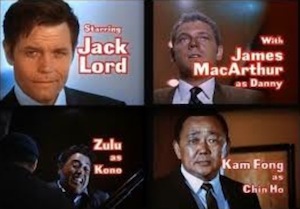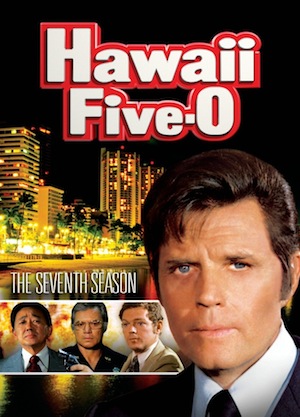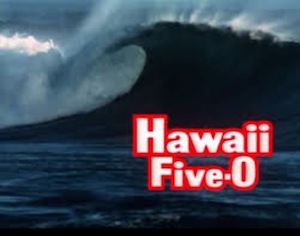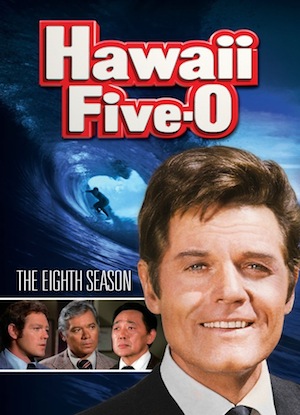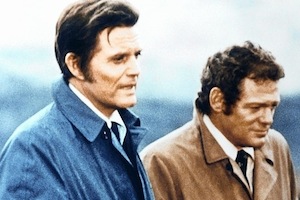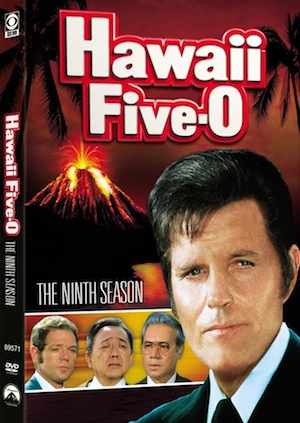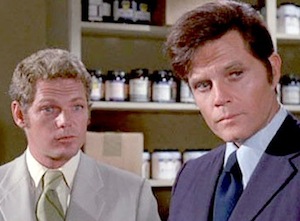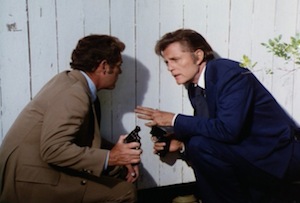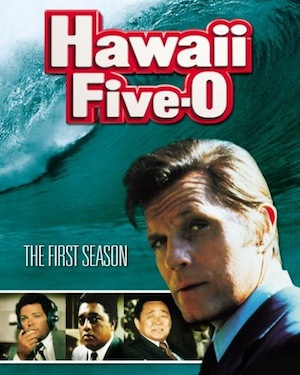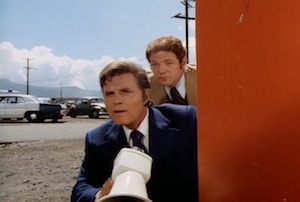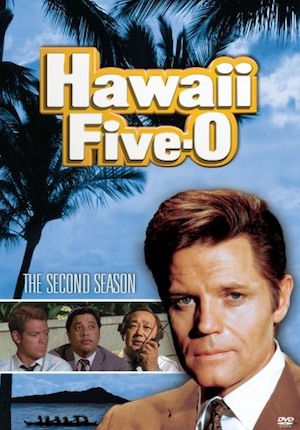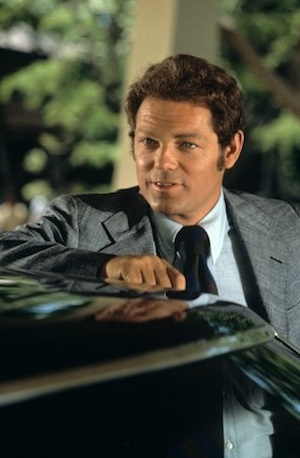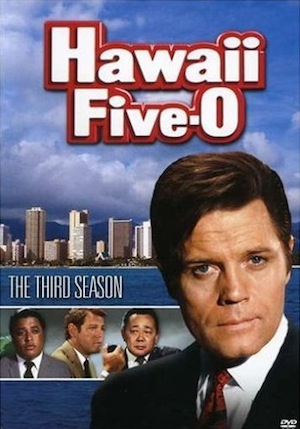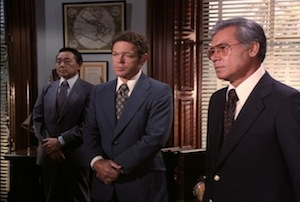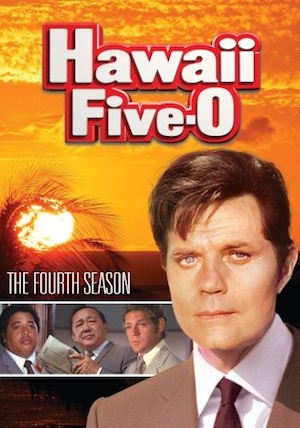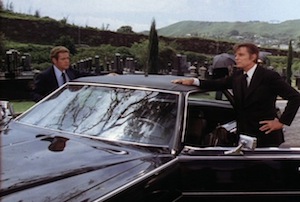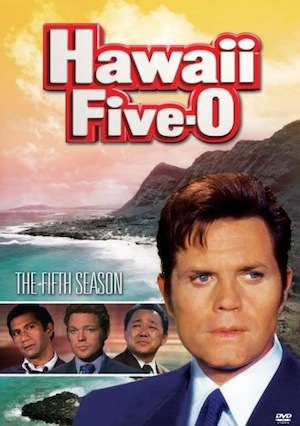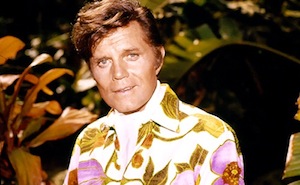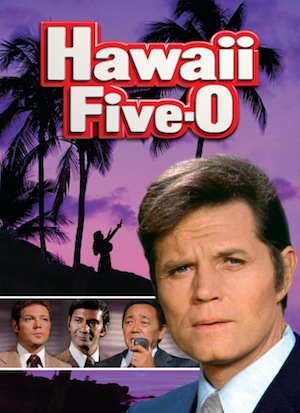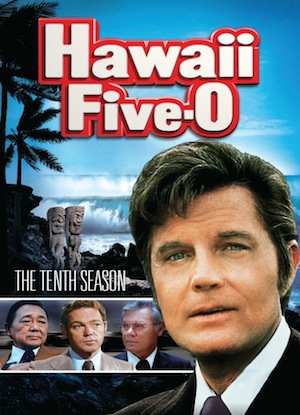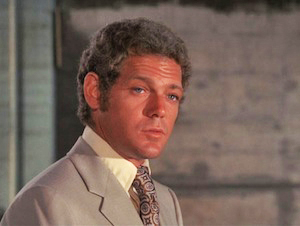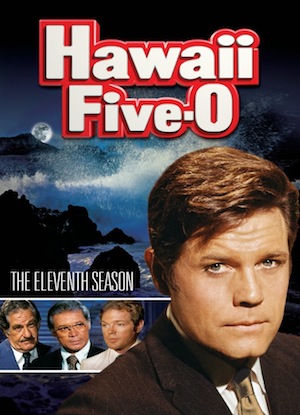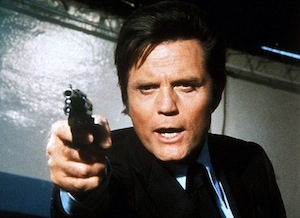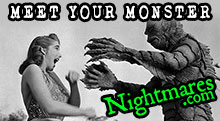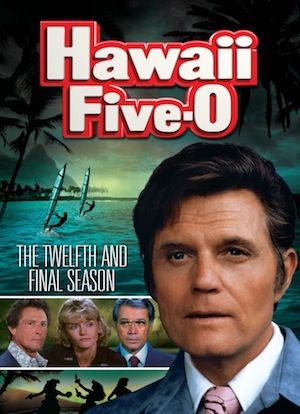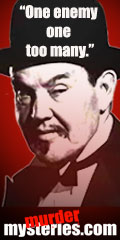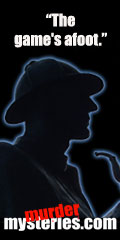Hawaii 5-O
Hawaii Five-O was an American police procedural produced by Leonard Freeman. Set in (you guessed it) Hawaii, it aired for 12 seasons from 1968 to 1980, and is a staple of syndication. Jack Lord portrayed archetypal Detective Lieutenant Steve McGarrett, the head of a special state police task force that was actually based on a real unit in the islands that existed under martial law in the '40s.
See the Hawaii Five-O Show Intro
Hawaii Five-O was named in honor of Hawaii's being the 50th state. The letter "O" sometimes differentiates the original series from the 2010 reboot, which always uses the numeric zero.
In the show, ex-US naval officer Steve McGarrett (Jack Lord) led a fictitious state police force made up of young officer Danny Williams (James MacArthur), Chin Ho Kelly (Kam Fong Chun), and Kono Kalakaua (played by Zulu). Honolulu Police Department Officer Duke Lukela (Herman Wedemeyer) later joined McGarrett's team as a regular, along with Ben Kokua (Al Harrington), who replaced Kono in the fifth season.
For 12 seasons, McGarrett and his team made life miserable for international secret agents, criminals, and Hawaiian organized crime syndicates. Helped by D.A. John Manicote (Glenn Cannon), McGarrett sent his foes off to prison at a prodigious rate. Most episodes ended with the arrest of the criminals and McGarrett snapping out his righteous, “Book 'em.” Often he spoke them to Danny Williams in what became one of TV's best known catch-phrases: “Book 'em, Danno” or “Book 'em, Danno, Murder One.”
Hawaii Five-O's criminals and crime bosses were played by such actors as Ricardo Montalbán, Gavin MacLeod, and Ross Martin in recurring roles. By the last season, MacArthur had left the show, having grown tired of the role, as had Kam Fong. But at Fong's request, Chin Ho didn't just disappear; he was murdered while working undercover.
McGarrett's immaculately coiffed hair and preference for dark suits and ties (uncommon in the islands) made fast headway into the popular culture. While the other members of the show often “dressed mainland”, they also frequently donned the ubiquitous Aloha shirt.
McGarrett's nemesis was a rogue intel officer of the People's Republic of China named Wo Fat (played by veteran actor Khigh Dheigh). Hawaii Five-O's final episode, “Woe to Wo Fat,” finally saw McGarrett put him behind bars.
The show's dramatic focus on McGarrett's crime fighting left little time for personal stories with wives or girlfriends, though a two-parter in Season One did deal with the loss of the baby of McGarrett's sister, and there were also occasional flashbacks to his younger years and romantic interests. But overall, McGarrett, like Dragnet's Joe Friday, was wedded to his work. The same went for Danno, although a 1975 episode involving his aunt (played by MacArthur's adoptive mother Helen Hayes) offered a brief glimpse into Williams's back story.
In the episode “Number One with a Bullet, Part 2,” McGarrett excoriated a criminal, “It was a bastard like you who killed my father”. His 42-year-old father had been run down and killed by someone who'd just held up a supermarket. Since McGarrett was also a Naval Reserve Commander, he'd occasionally take advantage of their resources in his cases, acknowledging their help in the show credits.
Hawaii Five-O was unique for its use of actual phone numbers in its scripts, instead of the fictional "555" prefix, at least for the first half of its run.
Show History
Producer Leonard Freeman supposedly moved to Hawaii to recuperate from a heart attack. According to one source, the idea for the show came in a conversation between Freeman and Hawaii's then-Governor, John Burns. But another source says Freeman wanted to set a show in San Pedro, California, until his friend Richard Boone talked him into shooting it entirely in Hawaii. Yet a third source contends that Freeman discussed the show with Burns, but only after pitching it to CBS. At one point, Freeman even considered calling the show “The Man”.
Jack Lord wasn't Freeman's first choice to play Steve McGarrett. That honor goes to Richard Boone, who turned the role down. Other actors under consideration included Gregory Peck and Robert Brown. Lord, who was living in Beverly Hills when he first heard about the part, read for it on a Wednesday, was cast almost immediately, then flew to Hawaii two days later. The next Monday he was in front of the cameras, making TV history.
Kam Fong Chun, an 18-year Honolulu Police Department veteran in real life, auditioned for the part of lead villain Wo Fat, but Freeman cast him as Chin Ho Kelly instead. Freeman took the name Wo Fat from a restaurant in Honolulu. The name Chin Ho was slightly shortened from the moniker of an executive named Chinn Ho, who owned the Ilikai Hotel where the penthouse shot of Steve McGarrett in the opening title sequence was taken. Zulu was a Waikiki beach boy and local DJ when he was cast as Kono, whom he played for four years.
A rusty military Quonset hut in Pearl City served as the show's shooting stage for the first year. Cast members quickly dubbed it “Mongoose Manor”. The roof leaked, and rats feasted on the electrical cables. By the start of the second year the show had moved, blessedly, to a Fort Ruger location, where it stayed for the next seven years. A third studio at Diamond Head was built and used for the last four seasons.
Hawaii's lack of a native movie industry meant that much of the crew and cast, including many locals employed by the show, had to learn their jobs as they went along — a task made more difficult by Jack Lord, who had a short temper and was a notorious perfectionist. Years later, in reunions, cast and crew admitted that Lord's high standards made Hawaii Five-O a better show.
There was no question that Lord was the center around which Hawaii Five-O revolved. The other actors often served as spectators while McGarrett paced to and fro, analyzing a given crime's details and emoting, though occasionally episodes let the focus widen to include members of the supporting cast. In “The Clock Struck Twelve”, for instance, Danno took center stage for the defusing of a bomb. But because Jack Lord had a financial interest in the show, the other regulars were always referred to using the word “with”, as in “with James MacArthur”. “Co-stars” they could never be.
Whatever its shortcomings in terms of fairness or apportionment of creative credit, Hawaii Five-O was, from a production standpoint, authentic: the overwhelming majority of its episodes were shot in the islands. Over its 12-year history, only a handful of episodes were made anywhere else — two episodes were shot in Los Angeles, one in Hong Kong, and another in Singapore.
Its famously atmospheric title sequence was the work of noted TV director Reza S. Badiyi. Early shows opened with sinister plot suggestions for the evening's episode, then cut to the iconic big wave, and then the theme song kicked in. Cut to a fast zoom-in to the top balcony of the Ilikai Hotel, with McGarrett turning just so into the camera, followed by a barrage of quick-cuts and freeze-frames of Hawaiian scenery and beautiful local talent, culminating in obligatory shots of the supporting players and the flashing blue strobe light of a police motorcycle racing through the streets of Honolulu.
As each episode wrapped up, Jack Lord narrated a promo for next week, often teasing the “guest villain”, especially if they were a recurring character (i.e. someone like character actor Hume Cronyn). “This is Jack Lord inviting you to be with us next week for {insert name of episode}” he would say, with quiet authority and assurance. “Be here. Aloha.”
Hawaii Five-O held the title for being the longest running crime show on American television until 2003, when Law & Order surpassed it. When the show bowed in 1968, Hawaii had been a state for just nine years, and was somewhat obscure to most Americans. Now it's a cultural and tourism colossus — a transformation Jack Lord surely played no small part in.
An interesting fact about the Hawaii-based series Magnum, P.I. is that it was created at least in part to make further use of Five-O's expensive production facilities. The first few Magnum P.I. episodes even made direct references to Five-O, suggesting a shared fictional universe. Magnum’s producers tried to lure Jack Lord out of retirement as a guest star, but to no avail.
Demographically, the great majority of characters in the show were People of Pallor, in stark contrast to the 40% of the state population who self-identify as caucasian. But many ethnic island locals found profitable employment with Hawaii Five-O, which was a diverse enterprise for its time.
The one-hour pilot for the revived show, Hawaii Five-0 (with its trailing zero), aired in late September of 2010 on CBS, and as of October 2013, the series airs Friday nights at 9 PM Eastern, 8 PM Central. The remake uses the same character names as the original, and the new Steve McGarrett's late father's vintage '74 Mercury Marquis is the actual specimen driven by Lord in the original's last years. The new series opening credits pay homage to the original, although the theme song has been cut from 60 to 30 seconds. Most of the iconic shots are replicated, starting with the aerial approach and close-up turn of McGarrett at the Ilikai Hotel penthouse, the jet engine intake, a hula dancer's swiveling hips and all the rest, right up to the police motorcycle's flashing blue light. On the March 19, 2012 episode, veteran actor Ed Asner reprised his role as “August March”, a villain he first played opposite Lord's McGarrett more than thirty years ago.
Another legacy of the show is the lasting popularity of its theme music, which was composed by Morton Stevens, who also created episodic music for the show. Originally recorded by the Ventures, (who rode it to #4 on the Billboard Hot 100 back in the day), it's an enduring favorite of high school and college marching bands — particularly, as you might guess, at the University of Hawaii.
